UK Road Signs and Meanings - A Complete Guide
Whether you have just learned to drive and passed your test or have been on the road for many years, understanding road signs in the UK is crucial. Road signs are a key part of the UK Highway Code Road signs system, which helps ensure traffic moves safely and efficiently around the road network.
For learners who are now in the early stages of driving, knowing the different UK road signs' meanings is especially important, as you may not have come across every type of road or junction yet. In this guide, we'll clarify the most common signs you will see throughout your driving journey, so that you're feeling confident for the UK road signs theory test, a UK road signs quiz, or just day-to-day driving.
Different Shape Road Signs Mean Different Meanings
Understanding the different shapes of UK road signs will help you identify their meanings more quickly and accurately. Each shape will very promptly inform the driver whether the sign indicates an order, a warning, or information. This is particularly useful when preparing for the UK road signs test or quiz.
CIRCULAR Signs: These shapes mean orders. A blue circle denotes a positive instruction (e.g., keep left), while a red circle indicates a prohibited action (e.g. no entry).

TRIANGULAR Signs: This shape indicates warnings. These signs identify potential hazards (e.g., slippery roads, sharp bends, pedestrian crossings).
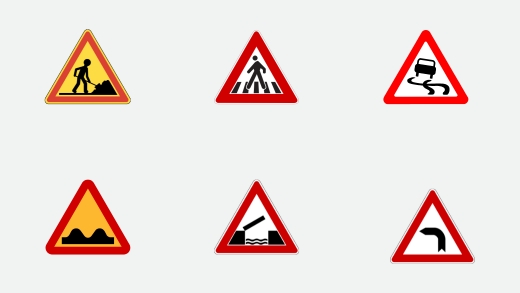
RECTANGULAR Signs: Rectangle-shaped Road signs convey information. These signs either provide directions, inform of speed camera zones, or provide valuable information about what is ahead.
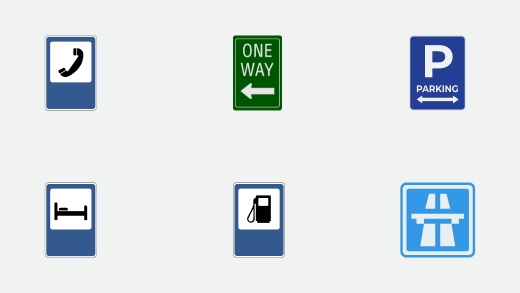
By remembering this simple principle, you will be able to quickly recall UK road sign meanings regardless of whether you are revising to take the test or on a day-to-day driving basis.
Common Types of British Road Signs and Their Meanings
Understanding British road signs is a crucial aspect of driving safely and confidently. All UK signs are explained in more detail in the Highway Code, UK road signs section, but it is helpful to understand the most common signs and their meanings as part of your preparation for your UK road signs test or in real-life driving.
1. "National Speed Limit Applies" Sign
The meaning of this speed UK road sign is a white circle with a black line around it, indicating the national limit that applies (60mph on single carriageways, 70mph on dual carriageways and motorways). It is one of the best-known signs on rural roads.

2. "Maximum Speed" Sign
This road sign features a red circle with a number indicating the highest legal speed; for example, "30" means that you cannot drive faster than 30mph on the road.

3. "Speed Camera" Sign
This is a rectangular warning sign with a black camera symbol for speed checks ahead. It is very often included in UK road signs quiz questions. If caught exceeding the limit, drivers can face fines, penalty points, or even disqualification. For a complete understanding, read more about UK speeding fines and penalties
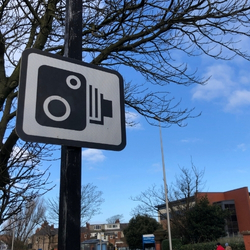
4. "Give Way to Traffic on Major Road" Sign
An upside-down triangle with 'Give Way' indicates that you should allow vehicles on the main road to pass before you move onto the road.
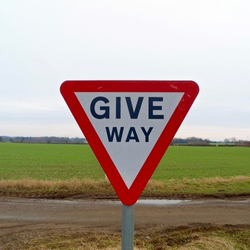
5. "No Stopping" Sign
Stopping anywhere on that street is not allowed. More emphatic than 'no waiting' laws.
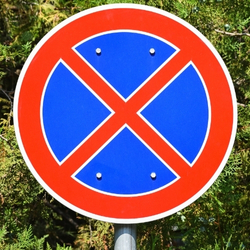
Drivers often confuse No Stopping with a Clearway, but the two are not the same. Check out this detailed guide on Clearways. So, you won't get confused.
6. "No Waiting" Sign
You cannot park or wait, but dropping off passengers temporarily is allowed.

7. "No Motor Vehicles" Sign
A 'no motor vehicles' signal (a red circle with a motorbike over a car) indicates that motor vehicles are banned within that area; it is often used where the intention is to route pedestrians and cycle traffic without interruption from cars and vans.
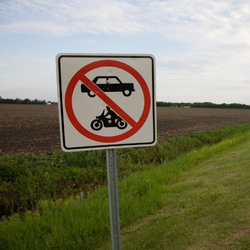
8. "No Entry for Vehicular Traffic" Sign
The UK road signs' No Entry' symbol (a red circle with a white bar) prohibits vehicular traffic from entering the street or zone.
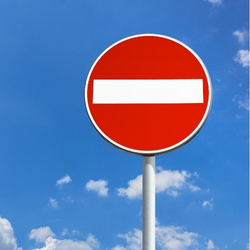
9. "Traffic has Right of Way Over Oncoming Traffic" Sign
This sign, which shows a black continuing arrow with a smaller red arrow, gives you the right of way if you are being faced with approaching vehicles from the opposite direction.
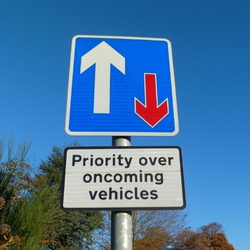
10. "T-Junction" Sign
This triangular warning, with a black "T" shape, shows the location where a road meets another road, reminding drivers to be prepared and check intersection regulations for giving way, if applicable.

11. "Traffic Queues Likely Ahead" Sign
A triangle with black signs showing cars is warning of traffic queues ahead. Often seen on motorways and busy roads (A-roads).
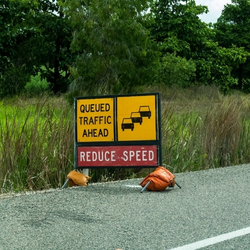
12. "No Overtaking" Sign
This sign depicts a red car and a black car inside a circle, indicating a strict law prohibiting overtaking.

13. "Two-Way Traffic" Sign
The two arrows showing traffic heading in opposite directions inside a triangle indicate that traffic is now travelling both ways.
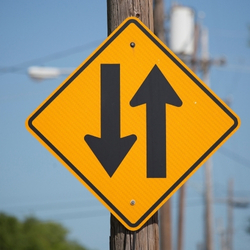
14. "Slippery Road" Sign
The red triangle warning of a slippery area indicates a car with water marks left behind. This typically means a slippery road, often due to rain, ice, or an oil spill.

15. "Steep Hill Downwards/Upwards" Sign
These triangles indicate a steep hill with a percentage; warning drivers they may have to brake heavily or change gears.

16. "Dual carriageway ends" Sign
A triangle sign with two merging lines indicates that the dual carriageway is nearing completion, and two-way traffic will now be in effect.
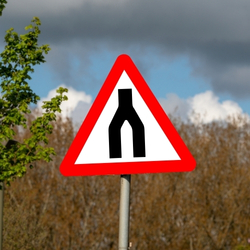
17. "Road Narrows Both Sides" Sign
Two lines converging inward towards one another, within a triangle, would indicate that the road is approaching, and one must drive more cautiously and slowly.
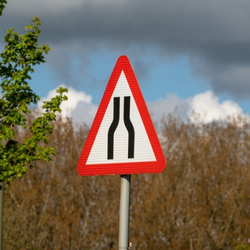
18. "Pedestrians in Road Ahead" Sign
The triangle, with a person walking figure as a warning, indicated that pedestrians might be crossing or walking along the road ahead.
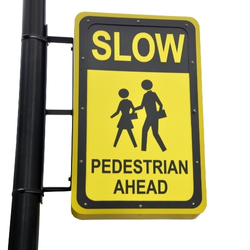
19. "Road Humps Ahead" Sign
The rectangular-shaped triangle with a bump indicates road humps directly and ensures drivers slow down for safety.
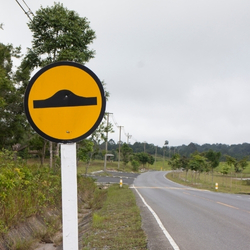
20. "Other Danger" / "Hidden Dip" Sign
The spotted triangle with an exclamation mark indicates a hazard, accompanied by text to clarify the hazard, such as "hidden dip" or "blind summit".
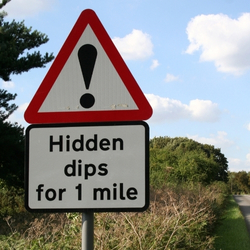
21. "Vehicles Height Limit Sign"
This sign typically indicates a circular restriction and illustrates the maximum vehicle height (e.g., 3.0m) that vehicles can have before entering under a bridge or tunnel.
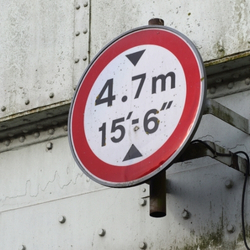
22. "No Vehicles" Sign
A rectangular red T-shape indicates that there is no through-road for vehicles, typically found at the end of a cul-de-sac or at a dead end.

FAQs
1. What are the 30 road signs in the UK?
The 30-road sign in the UK indicates a maximum speed limit of 30 miles per hour. It is usually found in built-up areas, towns, and residential streets to ensure the safety of pedestrians and other road users.
2. How to remember road signs in the UK?
To remember UK road signs, group them by shape and colour. For example:
- Circular signs - Give orders (red circles usually mean "don't").
- Triangular signs - Give warnings.
- Rectangular signs - Provide information.
Using flashcards, practice apps, and mock theory tests also helps in memorising them quickly.
3. What is the rarest road sign in the UK?
One of the rarest road signs in the UK is the "No Vehicles Carrying Explosives" sign. It is used only in sensitive areas, such as military sites, tunnels, or fuel depots, making it very uncommon for everyday drivers.
4. What is the most ignored road sign?
The "Keep Left" bollard sign and "No U-Turn" sign are often ignored by drivers. Many road safety experts also note that yellow box junction markings are usually overlooked, leading to traffic congestion and fines.
5. What UK road sign means no stopping?
A red clearway sign indicates "No Stopping." This means vehicles cannot stop at any time, not even briefly, except in the event of an emergency.
6. Why are stop signs rare in the UK?
Stop signs are rare in the UK because the country relies more on "Give Way" signs and road markings. Roundabouts and priority systems are designed to ensure that traffic flows smoothly without requiring a full stop at every junction.
7. What is the diamond sign in the UK?
The white diamond road sign in the UK is used to indicate tram and bus lanes. It indicates that specific rules apply to lanes reserved for public transport or trams.
8. What is the least-used road in the UK?
According to traffic data, some of the remote rural roads in Scotland and Wales are the least used. For example, the A897 in the Scottish Highlands has been recorded as one of the quietest A-roads in the UK.
9. What happens if I don't follow the UK road signs?
Ignoring UK road signs can lead to fines, penalty points, license suspension, or even prosecution if it results in dangerous driving. Road signs are legally enforceable, so failing to follow them puts both drivers and other road users at risk.
10. What is the most important road sign in the UK?
The "Stop" sign is considered one of the most important road signs in the UK. Ignoring it can have profound consequences, and drivers are legally required to come to a complete stop at these junctions.
Conclusion
Learning the Highway Code and practicing with UK road signs is vital for safe and confident driving. By understanding the meanings of these common British road signs, you'll not only pass your test but also become a more responsible driver every day.
At the same time, road safety isn't just about knowledge and awareness; it's also about being prepared for the unexpected. That's where Warranty Direct, one of the UK's leading providers of extended car warranty services, comes in. With flexible plans, affordable coverage, and nationwide garage support, Warranty Direct protects drivers from costly repair bills, offering complete peace of mind on every journey.
So, whether you're gearing up for your UK road signs test, mastering the Highway Code UK Road Signs, or simply enjoying the drive, having the right car warranty ensures your vehicle is as ready as you are. With Warranty Direct by your side, you can focus on driving safely and confidently, knowing your car is protected.
